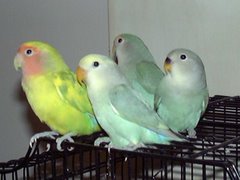Feeding Lovebirds During Breeding Season
Egg food has proven to be valuable, too. It is a perfect supplement to the diet of most seed-eating birds during the breeding season. A great many of the problems that a bird breeder may experience are either directly or indirectly related too incorrect feeding.
It could be the case that the birds are being given too much food, but it could also be the case that a certain ingredient, which is absolutely essential for a particular species of bird, is not being given.
The types of problems that are likely to occur include:
- Eggs not hatching
- Parent not taking proper care of their young one
- Birds starting on new brood too soon
- Before the young that came out of the first eggs are able to fend for themselves
- Mortality among the young and
- A complete lack of breeding results
Mistakes relating to the type of food given are often made long before the birds start breeding. If birds that are going to be used for breeding purposes have not had a good basis, they will start thee breeding season in a mediocre condition.
Even when the young have already left the nest, it is still necessary to give the parents some extra food. They have exerted themselves and need some extra nutrient to regain their strength. This is why the importance of good food should never be underestimated.












 Free Ads For Bloggers
Free Ads For Bloggers

